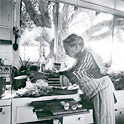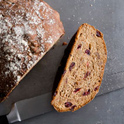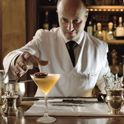The trick in coating the salmon with aspic is to have the fish very cold and the aspic so cold it is almost starting to congeal. Then as soon as it is spread on the fish, it will start to jell immediately. What aspic is left can be chopped and arranged on the platter between the garnishings. In serving, the salmon is cut like the piece of boiled salmon.
Salmon is always on the summer menus of fine eating places. Not a day goes by without at least one very large specimen on the cold buffet for luncheon. And we have had accidents, like the time there was a sudden demand for another cold salmon for the buffet only a few minutes after the first one had gone upstairs from the kitchen. What was that for, I wondered? Well, it seems that a piece of ice on the tray around the salmon platter had slipped under the platter of fish without the waiter's realizing it. As he carried the big heavy tray to the table, the platter started to skid on the ice, and before he knew it, platter and fish went sailing off the tray onto the floor.
In addition to the large salmon displayed and served on the buffet, we have often cooked weekly two to three hundred smaller salmon fresh from the Gaspé. These are boiled for serving hot with hollandaise and cold with mayonnaise and for such hot dishes as saumon Chambord, in which the fish is cooked in red wine, and saumon Joinville and saumon Admiral, two dishes in which the fish is cooked in white vine. But before I give you the recipes for these salmon dishes, let me give you a hint for telling when a slice of soiled or broiled salmon, sometimes called a salmon steak, is done. After about 12 to 15 minutes' cooking, test by patting the point of a small, sharp knife or a kitchen skewer in the middle of the round bone from which the smaller bones radiate. If you can lift out the bone without any of the flesh of the salmon with it, then the full is cooked.
Saumon Chambord
Melt 1 tablespoon butter in a kettle large enough for the fish. Add 1 medium-sized onion, chopped, and 1 carrot, chopped, and cook until they start to brown. Add 1 clove garlic, 2 shallots, a little thyme, 1 small buy leaf. 2 sprigs parsley, the peelings and chopped stems of 12 to 15 mushrooms, reserving the rest, ½ teaspoon salt, and a few peppercorns. Lay the fish on top of this and add 1 pint red wine and 1 cup fish stock or water. Cut a piece of paper the size of the pan with a tiny hole in the center. butter one side, and place the buttered side on top of the fish. This trick insures the fish's cooking on the top and the underside as well as keeping the whole moist and flavorful. Cover the pan, bring to a boil, and put in a moderate oven (350° F.) or on top of the range over medium heat. Cook for 35 to 40 minutes for a baby salmon of 3 to i pounds, longer for a heavier fish.
Meanwhile, cook the extra mushrooms in ½ cup water mixed with the juice of ½ lemon and 1 teaspoon butter for 5 minutes. When the fish is done, or when the bones separate easily from the flesh when tested with a knife, remove from the kettle. Discard the skin and ark flesh and place on a platter. Remove the mushrooms from their cooking liquor, saving the liquor, place them on top of the fish, and cover with a piece of warm cheesecloth.
To make the sauce, add the mushroom liquor to the liquid in the fish kettle and cook until reduced to about half the original quantity. Strain. Make a roux by melting 3 tablespoons butter, adding 1 tablespoon flour, and cooking together until the mixture starts to turn golden.Add the strained cooking liquor, mix, and cook, stirring gently until the sauce coats the back of the spoon. Strain through a fine sieve or cheesecloth and season with salt and pepper. For a richer sauce, add a little more butter, swirling it into the sauce. Coat the fish with this sauce and garnish the dish with 12 to 15 cooked shrimp or crayfish, with quenelles of fish decorated with pieces of (ruffle, and croutons fried in butter or crescents of puff pastry. called fleurons.
Another way of making the sauce is to reduce the liquor to half the original quantity and strain. Reheat and add beurre manié, made by creaming 3 tablespoons butter with 1 ½ tablespoons flour, swirling it in to blend with the liquid. Bring to the boiling point but o nor allow to boil.


 Pinterest
Pinterest






